
Asimina is a genus of small trees or shrubs described as a genus in 1763. Asimina is the only temperate genus in the tropical and subtropical flowering plant family Annonaceae. Asimina have large, simple leaves and large fruit. It is native to eastern North America and collectively referred to as pawpaw. The genus includes the widespread common pawpaw Asimina triloba, which bears the largest edible fruit indigenous to the United States. Pawpaws are native to 26 states of the U.S. and to Ontario in Canada. The common pawpaw is a patch-forming (clonal) understory tree found in well-drained, deep, fertile bottomland and hilly upland habitat. Pawpaws are in the same plant family (Annonaceae) as the custard apple, cherimoya, sweetsop, soursop, and ylang-ylang; the genus is the only member of that family not confined to the tropics.

Helianthus is a genus comprising about 70 species of annual and perennial flowering plants in the daisy family Asteraceae commonly known as sunflowers. Except for three South American species, the species of Helianthus are native to North America and Central America. The best-known species is the common sunflower. This and other species, notably Jerusalem artichoke, are cultivated in temperate regions and some tropical regions, as food crops for humans, cattle, and poultry, and as ornamental plants. The species H. annuus typically grows during the summer and into early fall, with the peak growth season being mid-summer.

Rudbeckia is a plant genus in the Asteraceae or composite family. Rudbeckia flowers feature a prominent, raised central disc in black, brown shades of green, and in-between tones, giving rise to their familiar common names of coneflowers and black-eyed-susans. All are native to North America, and many species are cultivated in gardens for their showy yellow or gold flower heads that bloom in mid to late summer.

Baptisia is a genus in the legume family, Fabaceae. They are flowering herbaceous perennial plants with pea-like flowers, followed by pods, which are sometimes inflated. They are native to woodland and grassland in eastern and southern North America. The species most commonly found in cultivation is B. australis.
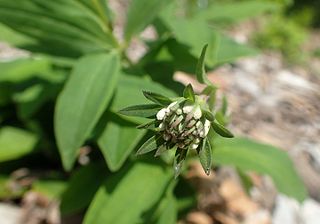
Marshallia is a genus of plants in the tribe Helenieae within the family Asteraceae. Marshallia is native to the southeastern and south-central United States. A common name applied to most species in the genus is Barbara's buttons.
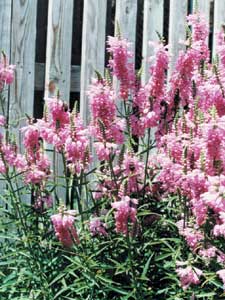
Physostegia, the lionshearts or false dragonheads, is a genus of flowering plants in the family Lamiaceae, native to North America. They are erect rhizomatous herbaceous perennials inhabiting damp, sunny places. They grow up to 2 m (7 ft) tall with purple or pink tubular flowers in racemes in summer.

Thermopsis is a genus of legumes, native to temperate North America and east Asia. They are herbaceous perennials and are known as goldenbanners or false-lupines.

Iva is a genus of wind-pollinated plants in the family Asteraceae, described as a genus by Linnaeus in 1753. Plants of this genus are known generally as marsh elders. The genus is native to North America.

Oenothera fruticosa, the narrowleaf evening primrose or narrow-leaved sundrops, is a species of flowering plant in the evening primrose family.
Coreopsis nudata, the Georgia tickseed, is a herbaceous perennial plant species of the genus Coreopsis in the family Asteraceae. It is native to the southeastern United States, in the states of Georgia, Florida, Alabama, Mississippi, and Louisiana.
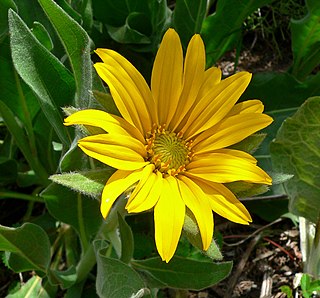
Wyethia is a genus of North American flowering plants in the family Asteraceae. First published by Thomas Nuttall in J. Acad. Nat. Sci. Philadelphia vol.7 on page 39 in 1834.
Astranthium, or Western-daisy, is a North American genus of flowering plants in the family Asteraceae. Astranthium is native to the United States and Mexico.
Chrysoma is a genus of flowering plants in the family Asteraceae.
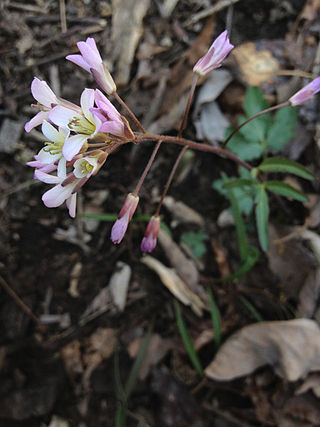
Cardamine angustata is a perennial forb native to the eastern United States, that produces white to pink or purple flowers in early spring.
Arisaema quinatum is a species of flowering plant in the arum family Araceae. It is a member of the Arisaema triphyllum complex, a group of closely related taxa in eastern North America. The specific name quinatum means "divided into five lobes", a reference to its characteristic leaves. It is commonly known as the southern Jack-in-the-pulpit but some refer to it as Preacher John.

Balduina uniflora, commonly called oneflower honeycombhead, savannah honeycombhead or oneflower balduina, is a North American species of plants in the sunflower family. It is native to the southeastern United States. It is the type species of the genus Balduina.

Balduina atropurpurea, the purpledisk honeycombhead, is a North American species of plants in the sunflower family. It is native to the southeastern United States.
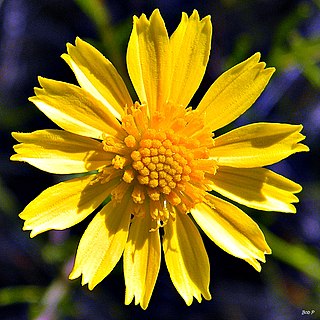
Balduina angustifolia, the coastal plain honeycombhead, is a North American species of plants in the sunflower family. It is native to the southeastern United States.
Croptilon divaricatum, called the slender scratchdaisy, is a North American species of flowering plants in the tribe Astereae within the family Asteraceae. It is native to the southeastern and south-central United States, in the states of Texas, Oklahoma, Arkansas, Louisiana, Mississippi, Alabama, Florida, Georgia, Virginia, and the Carolinas.
Seymeria is a genus of flowering plants belonging to the family Orobanchaceae.













